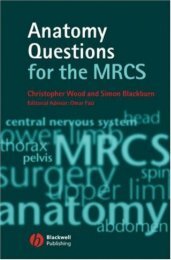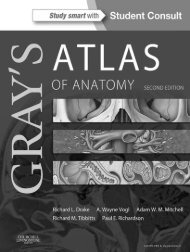theanatomyandphysiologylearningsystem4epdfdr-150930024720-lva1-app6891
You also want an ePaper? Increase the reach of your titles
YUMPU automatically turns print PDFs into web optimized ePapers that Google loves.
Chapter 1 Introduction to the Human Body 11<br />
Cranial<br />
cavity<br />
Ventral<br />
cavity<br />
Thoracic cavity<br />
Abdominopelvic<br />
cavity<br />
Abdominal<br />
cavity<br />
Pelvic<br />
cavity<br />
Spinal<br />
cavity<br />
Dorsal<br />
cavity<br />
Epigastric<br />
region<br />
Right<br />
hypochondriac<br />
region<br />
Right lumbar<br />
region<br />
Right iliac<br />
region<br />
Hypogastric<br />
region<br />
Left<br />
hypochondriac<br />
region<br />
Umbilical<br />
region<br />
Left lumbar<br />
region<br />
Left iliac<br />
region<br />
Figure 1-7 The two major cavities in the body and their subdivisions.<br />
Figure 1-9 Nine abdominopelvic regions formed by two sagittal<br />
planes and two transverse planes.<br />
To help describe the location of body organs or pain, health<br />
care professionals frequently divide the abdominopelvic cavity<br />
into regions using imaginary lines. One such method uses the<br />
midsagittal plane and a transverse plane that passes through<br />
the umbilicus. This divides the abdominopelvic area into four<br />
quadrants, illustrated in Figure 1-8. Another system uses two<br />
sagittal planes and two transverse planes to divide the abdominopelvic<br />
area into the nine regions illustrated in Figure 1-9.<br />
The three central regions are, from superior to inferior, the<br />
epigastric (ep-ih-GAS-trik), umbilical (um-BIL-ih-kal), and<br />
hypogastric (hye-poh-GAS-trik) regions. Lateral to these,<br />
from superior to inferior, are the right and left hypochondriac<br />
(hye-poh-KAHN-dree-ak), right and left lumbar, and<br />
right and left iliac (ILL-ee-ak) or inguinal (IN-gwih-nal)<br />
regions.<br />
Right upper<br />
quadrant<br />
Right lower<br />
quadrant<br />
Left upper<br />
quadrant<br />
Left lower<br />
quadrant<br />
Regions of the Body<br />
The body may be divided into the axial (AK-see-al) portion,<br />
which consists of the head, neck, and trunk, and the<br />
appendicular (ap-pen-DIK-yoo-lar) portion, which consists<br />
of the limbs. The trunk, or torso, includes the thorax, abdomen,<br />
and pelvis. In addition to these terms and the nine<br />
abdominopelvic regions identified in the previous section,<br />
there are numerous other terms that apply to specific body<br />
areas. Some of these are listed in Table 1-1 and are identified<br />
in Figure 1-10.<br />
Figure 1-8 Abdominopelvic quadrants that are formed by a<br />
midsagittal plane and a transverse plane through the umbilicus.<br />
Quick Check<br />
1.7 If the blood glucose level increases above normal, which<br />
is more likely to return it to normal: a positive feedback<br />
mechanism or a negative feedback mechanism?<br />
1.8 Which of the body planes would not intersect the<br />
hypochondriac and epigastric regions at the same time?<br />
1.9 Where would you expect the popliteal fossa to be<br />
located?

















